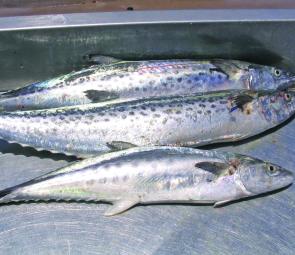The festivities are over for another year and now is the time to get stuck in to some serious fishing. It’s been pretty quiet lately but rough and very windy weather has kept anglers indoors. On the few odd occasions that the weather allowed boaties to get out, the ramps were bursting at the seams with keen anglers waiting to get out amongst them.
The outside reefs such as Barwon Banks and Caloundra Wide have produced some good dolphinfish with 15kg+ big bulls targeted. Mackerel have come on in a big way with spotties and Spaniards taking both live and dead baits and trolled lures. Trolling the outer edges of Currimundi Reef and Rapers Shoal in 20ft with bait or lures should produce.
If it’s mackerel you’re after, remember that birds are a dead give away. Mutton-birds are the best indicators of mackerel, as gulls and divers often lead anglers one or two then onto other pelagics. Small marlin and a few sailfish may also be finning the surface of the bait schools.
The northern part of the Barwon Banks and the top of the Hards should have bigger fish. These areas are around 35nm+ from Mooloolaba but are great fishing locations. Morning fishing sessions in 40m of water in the middle of the Banks are also shot for parrot, reds and lots of cod. Remember, cod are a good sign of a healthy system and ecosystems can collapse when they are removed. Leaving the bigger cod to breed can make a big difference down the track.
Most of the bigger reefies are in the deeper, cooler waters (80m+). Bigger pearl perch and large snapper will be out there if you’re prepared to travel.
Basalt Knob is another area worth a try. It’s a big hunk of basalt stuck out in the middle of the ocean and trolling the drop-off on the western and eastern edges can produce small blacks, sailfish and lots of dolphinfish. Bottom bashing early in the morning and late evening can provide plenty of quality fish. I’ve always found this area a great mid-summer location and it can fire when other places are quiet. The water depth varies from 80-112m with shallower areas towards the centre.
Trolling the 50m line just east of the Mooloolaba blinker can produce some pelagics. Cobia, amberjack and tuna species frequent the area. There are normally lots of boats around in February completing the long oval run around the drop-offs and reefs. Spotties and Spanish mackerel have been taken on the troll not to far out from Mooloolaba itself.
Murphys Reef has had a lot of traffic over the holiday period but still has quality reefies like cod, red emperor, squire and fingermark bream. Rat kings have been taken around Old Womens Island, the blinker and the coffee rock around Bribie’s northern tip. The coffee rock has had lots of baitfish around lately prompting catches of snapper, mulloway, cobia and amberjack. The Caloundra reefs still have stacks of good reefies and fishing at night is the best time to target snapper to 4kg, red emperor, Maori cod and a host of other pelagics. You’ll need more weight to keep the lines down in the strike zones and will need a #3, 4 ball at least if you are floating baits around the tide change.
I love fishing around the 5 and 7-mile reefs at Caloundra in February. I also visit the coffee rock off the northern tip of Bribie Island in the middle of the day to troll or float line for mackerel.
The closer in reef systems only produce for a limited period and your best bite period may only last 30-50 minutes. During that time you can expect to catch a big mixture of species and maybe get busted off once or twice. Evening is the best time to tackle these spots, preferably on a rising tide towards or just after dusk. Early mornings often see anglers landing a lot of undersize fish and only a couple of good quality ones, the opposite of evening fishing. This is also because daylight is fast approaching at 4.20am and the bigger fish start heading out to deeper waters.
The estuaries have been quiet but are producing good mangrove jack, flathead, bream and large whiting. Things will get back to normal with the holidays over and after recent rain falls we should see some great crabs and fish.
This month usually sees trevally and queenfish stealing live baits from anglers and a mass migration of live bait in the Pumicestone Passage. The best spots to try for mangrove jack are deeper south down the Passage around Egg Island area. If you’re after flatties, target the sand flats around the Powerboat club. Working these during the ebb tide is the most productive and 4” Gulp Turtle Back Worms and Squidgy black and gold fish are both working well.
Most of the beaches around the area have copped a pounding with strong northerlies followed by even stronger southeasterlies. This dumps lots of blue bottles and tons of weed in the water and makes it difficult to keep the bait free long enough for a hit. Anglers who work harder have pulled a few smaller mackerel from the beaches with plenty of dart and whiting around for a feed. The sheltered beaches like Kings and Moffat are the best bet in either of these big winds but it is difficult to get away from it all together.
We can expect a lot more of the above during the coming weeks with a marked improvement on bigger Spaniards and more billfish. I hope the weather holds a little better in February.
1.
Johnathan and Chris with a nice Mooloolaba Spaniard.
2.
Keen as mustard, straight from cricket to fishing.
3.
Spotties have been everywhere.
Reads: 3399






